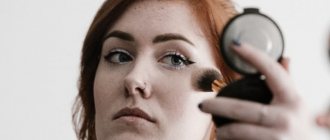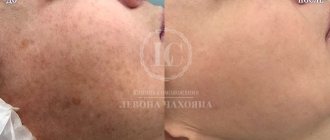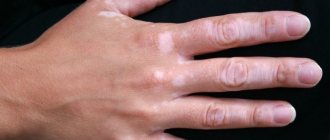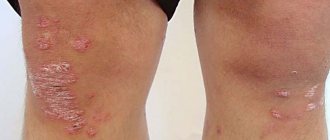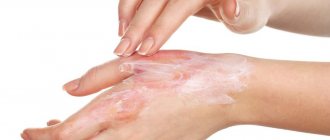Pigment spots are areas of the skin that have darkened for various reasons. They have a brown tint and are noticeably different in color from the surrounding tissues. Unlike skin changes caused by infections, injuries or fungi, age spots never become inflamed, so they are considered a purely cosmetic defect.
At the same time, in addition to deteriorating appearance, age spots cause other problems, often complicated by dryness and roughness of the skin, wrinkles, etc., which is why people try to get rid of them.
How is it formed
Every person from birth has a genetically determined skin color - the so-called permanent pigment.
When exposed to external and internal factors, an additional one is produced, which can be either a temporary physiological phenomenon (natural tanning) or a pathological one, difficult to remove even with special lasers (lentigo, vitiligo, etc.). The formation mechanism itself occurs in the epidermal layer. Here are located keratinocytes - epidermal cells. Their life cycle is up to 60 days, so they are constantly updated. To protect young and vulnerable cellular structures from sun exposure, melanocytes exist. They belong to the nervous system and are called upon to produce melanin, which absorbs ultraviolet radiation.
If the body is healthy, there is no overdose of solar radiation, melanocytes will produce a sufficient amount of protection. However, if there are failures, the “protectors” begin to be distributed unevenly, which leads to the formation of hyperpigmented areas.
How to be monitored if you have many moles?
In my practice, if a person does not have risk factors for developing melanoma, I recommend being seen by an oncologist for an examination with a dermatoscope annually in May at Melanoma Diagnosis Day. In addition to this, conduct a complete self-examination of the entire skin once every six months; you can examine a mole in a hard-to-reach place using two mirrors.
If a person has one or more risk factors, he or she should visit a dermato-oncologist for dermatoscopy once every 6 months and conduct a self-examination once every 3 months.
For those who have many moles (25, 50 or 100 - it doesn’t matter) and it seems difficult to monitor them, there is a type of dynamic monitoring called digital mapping of nevi.
Here's an example of how this happens in Germany:
This type of observation, according to the European Society of Clinical Oncology (ESMO), is considered the most adequate for patients with a large number of nevi:
According to data as of October 2022, such devices are available in Russia, Moscow and Yekaterinburg, the price for an examination can reach 10 thousand rubles.
Updated December 2022.
I am proud to announce that I am now conducting a similar examination in St. Petersburg.
Causes of hyperpigmentation
An increase in melanin production can be associated both with physiological changes occurring in the body and as a result of pathologies. The most well-known factors influencing the occurrence of stains are:
- endocrine diseases;
- hormonal changes during pregnancy or menopause;
- diseases of the gastrointestinal tract and adrenal glands;
- metabolic disorder;
- vitamin deficiency or hypervitaminosis;
- helminthic infestations;
- severe intoxication of the body;
- trauma or inflammatory processes;
- prolonged exposure to the sun;
- taking medications - antibiotics of the tetracycline group, gentamicins, erythromycins, as well as some NSAIDs, salicylic acid, antidepressants, diuretics, sleeping pills and sedatives, antihistamines, St. John's wort extract, etc.;
- heredity.
Changes can also appear due to prolonged stress. Since melanocytes belong to the nervous system, any fluctuations and unstable conditions lead to serious pigmentation disorders.
Localization of spots
They can have different sizes, both with clear contours and blurry ones, merge together or not grow at all. Depending on the differential diagnosis and the type of hypermelanosis, they can be located both in certain areas and without specific boundaries, covering absolutely any area of the body.
On the face
One of the most common sites of localization of many hyperpigmentations. This is due to the fact that the skin here is thin enough so that negative factors can attack them faster. Among the common phenomena are freckles, which can decorate the face all year round and also appear and disappear after exposure to the sun. They are also localized over the entire surface or located pointwise in the area of the cheeks, eyes, and forehead.
Anti-age drugs
Bb Laboratories – Delicate oil for deep cleansing
Laennec – solution for injection
Bb Laboratories – Two-phase serum concentrate
Two-phase placental serum concentrate
On the body
Namely on the arms, shoulders, chest, back, groin area. For each individual disease, there are areas where pigment accumulation is observed. For example, senile hyperpigmentation is typically located on the hands, forearms, and upper back.
How many moles is that? And which ones?
I will give 2 of the largest and most recent studies that I was able to find. Both works represent a meta-analysis, i.e. a synthesis of data from several clinical studies. In my opinion, this type of research is often more credible than a single study.
1. Study by Italian authors from 2005
Meta-analysis of risk factors for cutaneous melanoma: I. Common and atypical naevi.
The results of 46 individual studies are summarized.
Everything is the same, but in words: the risk of melanoma increases in direct proportion to the number of nevi, both ordinary and atypical. The minimum risk of developing melanoma is in a person with 15 or fewer nevi on the skin, no nevi on the hands, and no atypical nevi.
The maximum risk is for a person with more than 100 regular nevi, 15 nevi on the hands and 5 atypical nevi.
2. American study from 2010
Catherine M. Olsen, Heidi J. Carroll and David C. Whiteman
Estimating the Attributable Fraction for Cancer: A Meta-analysis of Nevi and Melanoma
The results of 49 studies were summarized.
The results are consistent with previous research.
The risk of melanoma increases with the number of common and/or atypical nevi on the skin.
In contrast to the previous study, it was noted that 42% of patients with melanoma had 25 or more common nevi and/or 1 or more atypical nevus.
The authors consider these patients to be a high-risk group and recommend more careful monitoring and training in self-diagnosis methods.
Unfortunately, neither in the first nor in the second study the authors make specific recommendations on the frequency and format of observation of patients at risk. We will try to formulate answers to these questions a little later.
Types and symptoms of age spots
Let's consider the most characteristic signs of hypermelanosis, as well as control methods that are relevant for each specific type of pathology.
Freckles
The most common type of melanin accumulation. They are mainly located on the face, in the cheek area. In advanced cases, they can completely cover the entire surface of the skin with small distances between the spots. And also have a round or oval shape, small diameter, clear contours.
Genetic predisposition plays a major role, so freckles can appear in childhood. People with red and blond hair are most susceptible to them. This is due to the need for high melanin production to protect the skin.
Freckles can be easily distinguished from other types of spots by the complete disappearance of pigmentation in cold weather, and the appearance of a whole scattering on the face with the arrival of warmth. Therefore, to combat them, creams with maximum sun filters are used throughout the year, as well as lightening cosmetics.
Melasma
Spots without clear boundaries and endings, varying in shade from bronze to dark brown. They have the ability to stretch, grow, and merge with each other into huge pigmented areas that occupy a large surface of the body. The main provoking factor is considered to be hormonal disorders caused by menopause, pregnancy, and the use of oral contraceptives. Treatments include peeling methods and procedures that promote cell renewal. When the root causes are eliminated, the stains quickly disappear.
Melasma
The second name is melanosis. It can be acquired or hereditary, manifests itself in the form of an accumulation of melanin with uneven but clear boundaries and localization in open areas of the body. May occur as a result of Addison's disease, hemochromatosis, due to sensitivity to ultraviolet radiation, anthracene or acridine substances, diseases of the pituitary gland, ovaries, adrenal glands, syphilis, tuberculosis, malaria, treatment with hormones. Pigmentation is accompanied by redness, itching, peeling, and roughening of the skin.
To prevent progress, sunscreens are used, drug therapy is prescribed with steroid groups, retinoids, hydroacids, and vitamins B (1.6) and C are additionally used.
Becker's nevus
A characteristic defect in men, it is much less common in women. The first manifestations can be as early as 10 years of age. It is a hyperpigmented area protruding above the surface of the skin, on which dark long hairs grow. It occurs both as a result of genetic factors and can appear after sun exposure, changes in hormonal levels, in particular androgens. The location most often is the upper back and chest; it is not often found on the legs, groin, or head. It has a warty surface on which acne or comedones can be seen. Does not respond well to any cosmetic procedures or medications. An argon laser is used to minimize the aesthetic defect.
Secondary
Occurs at the site of mechanical damage. They can be either deep cuts, scratches, or acne, comedones, ulcers and other superficial causes that trigger the inflammatory process in the skin cells. There is an excess of melanin, resulting in staining. They are localized where the damage was and go away after the area returns to normal and the inflammation disappears. To speed up the lightening process, you can use special lightening creams or cosmetic procedures aimed at renewing the epidermal layer.
Age
As we age, the negative effects of ultraviolet radiation lead to increased melanin production in certain areas of the body. These are usually open areas that have been exposed to a lot of sunlight during their lifetime. With age, spots appear with a diameter of 1 to 5 cm, which are darker in color than the entire surface of the skin.
Berlocc's dermatitis
Refers to contact types of immune response to irritants. Usually due to contact with perfumes, colognes, and deodorants. It is located where the skin came into contact with the substance. Symptoms may include not only a change in the color of the dermal layer, but also itching, peeling, and swelling. It disappears quickly, just stop using perfume and in a few days everything will return to normal.
Chloasma
Large spots can merge into one large skin defect. They do not have a clear contour or boundaries and can grow and increase in size throughout life. Among the provoking factors are pregnancy and lactation, menopause, changes in hormonal levels due to diseases, stress, taking oral contraceptives, steroids, the use of hormone-containing ointments and some cosmetics.
Face and body
There are a huge number of different reasons why skin hyperpigmentation appears. It can occur not only on the surface of the face, but also on the arms, back, legs, and abdomen. This may be due to genetics, various autoimmune disorders, excessive uncontrolled exposure to ultraviolet rays, insurmountable external circumstances, for example, the climatic characteristics of the region of residence, the environmental component, smoke or dust in cities.
Darkening on the stomach or back, on the arms or legs can appear after an inflammatory process in the epidermis. For some, insect bites cause light or dark areas of varying sizes that last a long time. Why is this happening? There are many prerequisites, they are worth discussing separately.
What causes pigment spots to appear on the face after sunbathing?
Most manifestations of hyperpigmentation occur after the negative effects of ultraviolet rays. Among those that immediately appear are freckles, various melasma and chloasma. There are also those that have a cumulative effect, for example, lentigo.
Also, if during the summer vacation there were inflammatory processes in open areas of the body, most likely after they heal, a change in shade can be clearly observed.
Prolonged exposure to the hot sun with the presence of existing tumors and increased pigmentation can be fraught with the degeneration of harmless spots into aggressive cancer - melanoma. Therefore, you should limit your tanning time and use special cosmetics for protection.
Age spots and peeling
Melanin accumulation occurs in the upper layers of the epidermis. In order to remove unaesthetic problems, products that stimulate the renewal of the dermis are used. The most effective peelings are: chemical, mechanical, laser. They promote the regeneration of epidermal cells, forcing keratinocytes to produce new ones as quickly as possible, which will not have a large accumulation of coloring pigment. When eliminating the root causes of hyperpigmentation, there is a chance that you will forget about various spots for a long time.
Pigmentation or hyperpigmentation of the skin - what is it?
In fact, there is nothing wrong with this term and such a defect has absolutely nothing to do with any diseases.
The dictionary definition states that this can be called the uneven distribution of coloring pigments over the surface of the epidermis. In our case, we are talking specifically about a substance such as melanin, produced by a certain type of cell (melanocytes). Excessive accumulation or deficiency can cause hyperpigmentation or, conversely, tissue discoloration. This is how dots and even extensive formations appear, which are clearly visible to the naked eye. However, not only this substance has coloring ability; there are others. These can be lipochromes, bilirubin, lipofuscin and many others, which are products of cell metabolism.
Causeless manifestations
It happens that people try to protect their skin, use special sunscreens, but hyperpigmented areas still appear. It's like it happens for no apparent reason. However, for melanocytes to malfunction, even a small but prolonged stress or temporary hormonal imbalance is enough.
It is also worth noting the cumulative negative effect of ultraviolet radiation, which can manifest itself over the years on areas of the body that received sunburn in early childhood. Therefore, only at first glance it seems that hypermelanosis arose without provoking factors. In fact, he has hidden reasons.
Liver pigment spots
Deterioration in the functionality of internal organs can also lead to the formation of aesthetic defects. The liver plays the role of a filter, retaining and processing all dangerous substances, and then removing them from the body. In cases where she fails to cope with her duties, slow but sure intoxication occurs, which is manifested not only by internal, but also by external pathologies.
Metabolic processes in tissues are disrupted, including the normal distribution of melanin; it accumulates in certain areas. Most often it appears on the face. The contours of such spots are not uniform, they do not have a clear boundary. The color can also vary from light to dark brown.
Lentigo
The phenomenon is popularly known as “senile ripples.” Appears in older people in areas of the body that have been exposed to intense ultraviolet rays throughout their lives. The pigment usually appears on the arms from the hands to the top of the shoulders, upper back, décolleté, and face. It is distinguished by its small size, different diameters and chaotic arrangement of spots.
The first manifestations can be noticed after 40 years; they noticeably age the appearance, so many people at this stage turn to cosmetologists to eliminate the defect. During menopause, hormonal changes lead to an increase in the amount of pigment. Chemical, mechanical and laser peels are used for treatment. Cosmetics and whitening creams will not cope with the problem.
What to do if there are a lot of moles on the body?
From the first study , we found that the likelihood of developing melanoma increases in direct proportion to the number of regular and/or dysplastic (atypical) nevi.
A second meta-analysis suggests that people with 25 or more common nevi and/or 1 or more atypical nevi are at risk for developing melanoma.
I think that after reading the previous paragraph, all readers were most likely divided into 3 groups:
- “I have a lot of moles and definitely more than 25, I’ll get melanoma! Oh God!"
- “I have less than 25 moles and I can now relax 100% about melanoma.”
- We ran to count the moles and realized that they couldn’t cope without a doctor.
It seems to me that there is no need to divide everything into black and white. Unfortunately, anyone can get melanoma. And those who have more than 25 moles, and those who have fewer, and even those who have only one or two moles. No one is 100% insured, it’s just that the probability is different for everyone. It is important to understand that the number of moles is just one of 17 risk factors for melanoma. I think that you shouldn’t draw any fatal conclusions and panic just because you have a lot of moles.
Solarium - is it harmful?
It is also a mistake to think that sun tanning is harmful, and nothing will happen in specialized salons in a few minutes. On the beach, the skin gets a lot of heat, but this happens gradually. In the booths, a loading dose of ultraviolet radiation is given in a few minutes, which is difficult to obtain outdoors even in a whole day.
People with a fair skin type, with the presence of moles and nevi, freckles, existing aesthetic defects in the form of increased melanin production, need to get rid of the habit of visiting a solarium. The consequences can be expressed both in the progression of unsightly changes in the epidermal layer, and in their degeneration into malignant neoplasms.
Relationship between the number of moles and the risk of melanoma
There is a lot of research on this issue. If you start reviewing everything, you will end up with a long and boring article that you will not be interested in reading, and I will not be interested in writing.
I have selected some of the largest studies that will help us form our own opinion on this issue.
However, before considering research data, let’s move from the folk concept of “mole” to the medical concept of “nevus”.
Diagnostics
To accurately determine the type of hypermelanosis, as well as to identify effective means of control, you need to contact a dermatologist. At the initial visit, the doctor will collect the patient's medical history to determine the most likely internal and external factors that will indicate a certain type of disorder. He will examine the skin and also prescribe a number of tests:
- AOK and OAM;
- blood biochemistry;
- Wood's lamp tests;
- scraping;
- biopsy.
If a malignant neoplasm or fungal infection is suspected, referrals will be given for the last two procedures on the list. As a result, the specialist will be able to accurately determine the type of illness and prescribe therapeutic or cosmetic procedures.
Anti-age drugs
Bb Laboratories – Hyaluron-elastin-collagen extract
Laennec – solution for injection
Curacen Essence (20 fl x 2 ml)
Two-phase placental serum concentrate
Hair and eye coloring
Few people know that the color of the iris also directly depends on the amount produced, the depth of occurrence and the total mass of the main coloring pigment. The shade of the iris becomes darker when there is more melanin in the body and vice versa.
The situation with hair is approximately the same; the lighter it is, the fewer compounds are produced. Over the course of life, due to various internal and external circumstances, its release may intensify or subside due to various pathological or physical phenomena.
How to fight
Among the modern and effective methods of struggle, it is worth highlighting:
- cosmetic preparations;
- laser peeling;
- phototherapy.
Depending on the variety, medications may be prescribed to address the underlying causes. However, to remove an aesthetic defect, it will be necessary to wait for the cell surface to renew itself, or to help it renew itself faster with the help of additional deep peeling and cosmetic photorejuvenation procedures.
Cosmetic preparations
Among the popular drugs that give noticeable results in the fight against hyperpigmentation are placental products with a high content of natural peptides, amino acids and hyaluronic acid, as well as vitamins, micro- and macroelements. Injection product Curacen (Curasen) and non-injection drug Curacen Essence (Curasen Essence) are the ideal choice of cosmetologists for triple action: brightening, moisturizing and eliminating wrinkles. You can also use specialized cosmetics from the Laennec Skincare brand - LNC. This line offers to transform the skin at the cellular level, eliminating and preventing hyperpigmentation.
Now you know about the main causes of pigmentation, as well as what causes the appearance of age spots on the face, and you can easily answer the question - what to do when pigments have already appeared. Dermatologists recommend not only limiting time spent on the beach and using sunscreen in summer, but also year-round use of skin protection from the negative effects of ultraviolet radiation. It is this that becomes the main catalyst, and in combination with internal disorders of the body can lead to serious changes in the epidermal layer.

